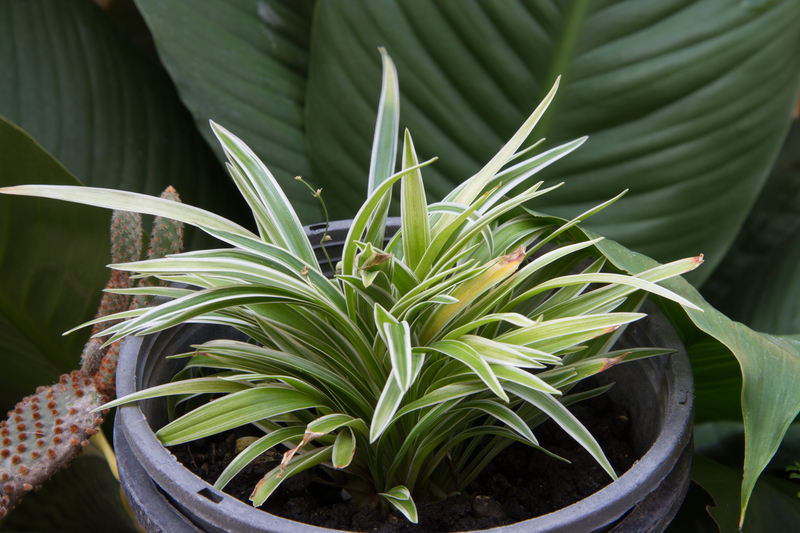Greenspaces as Climate Change Combatants: The Gardening Approach
Posted on 06/09/2025
Greenspaces as Climate Change Combatants: The Gardening Approach
Climate change is one of the most pressing challenges in the 21st century. Rising global temperatures, increasing greenhouse gas emissions, and unpredictable weather patterns continue to threaten ecosystems, urban environments, and human health. Amid these challenges, greenspaces emerge as vital tools in the fight against climate change. In particular, the gardening approach to creating greenspaces offers accessible, scalable, and effective means to mitigate environmental impacts. This article delves deep into how nurturing gardens and public greenspaces can act as powerful climate change combatants, exploring their benefits, best practices, and the transformative role they play in communities worldwide.

The Importance of Greenspaces in Tackling Climate Change
Greenspaces refer to any vegetated land within urban, suburban, or rural settings. These include parks, community gardens, backyards, rooftop gardens, green corridors, and even roadside plantings. The critical role of greenspaces in mitigating climate change is increasingly recognized by scientists, urban planners, and policy makers. Below are a few reasons why greenspaces are fundamental in the fight against climate change:
- Carbon sequestration: Plants in greenspaces absorb carbon dioxide--a major greenhouse gas--from the atmosphere through photosynthesis.
- Temperature regulation: Greenspaces cool the urban environment through shade and evapotranspiration, mitigating the "urban heat island" effect.
- Improved air quality: Vegetation filters pollutants and particulate matter, enhancing urban air quality.
- Stormwater management: Plants and permeable soils absorb rainfall, reducing flooding risks.
- Biodiversity enhancement: Diverse greenspaces support pollinators, birds, and other wildlife, contributing to ecosystem resilience.
The Gardening Approach: Small Acts, Big Impacts
While vast national parks and protected forests are often heralded as the lungs of the earth, small-scale gardens play a crucial role as well. The gardening approach involves harnessing the collective power of individuals, families, schools, and communities to transform underutilized spaces into green oases. Here's why gardening is a powerful climate action tool:
- Scalability: Gardens can be established by anyone, anywhere, regardless of the size of available land.
- Community engagement: Gardening fosters stewardship, collaboration, and environmental awareness at the local level.
- Resilient food systems: Edible gardens reduce food miles and promote local, sustainable agriculture.
- Personal well-being: Interaction with greenspaces enhances mental health, physical activity, and social interaction.
How Greenspaces Mitigate Climate Change
1. Carbon Sequestration through Gardening
The process by which plants capture and store atmospheric carbon dioxide is known as carbon sequestration. Through photosynthesis, trees, shrubs, and even smaller plants lock away carbon in their leaves, wood, and roots. Urban gardening--whether in small plots, urban farms, or rooftop planters--can significantly contribute to carbon sequestration.
Benefits include:
- Reducing the carbon footprint of cities and towns
- Improving air quality and reducing urban pollution
- Enhancing local biodiversity and ecosystem services
Did you know? According to the U.S. Forest Service, urban trees in cities like New York sequester over 900,000 metric tons of carbon dioxide each year, providing immense climate benefits.
2. Alleviating the Urban Heat Island Effect
Cities are often several degrees warmer than surrounding rural areas because of concrete, asphalt, and buildings that absorb and retain heat--a phenomenon known as the urban heat island effect. By increasing greenspaces through the gardening approach, communities can cool urban areas and offset these higher temperatures. Vegetated roofs, community gardens, and roadside plantings all contribute to lowering local temperatures, improving comfort during heatwaves, and reducing cooling energy needs.
3. Enhancing Stormwater Management
Climate change brings more frequent and intense rainfall events, leading to increased flooding risk, especially in cities with large impermeable surfaces. Gardening and greenspaces act as sponges, absorbing and filtering rainwater. Native plants, rain gardens, and permeable soils can dramatically reduce surface runoff, alleviating pressure on urban stormwater systems.
Greenspaces and Biodiversity: Building Resilience
Biodiversity is an essential component of resilient ecosystems. A wide variety of plants, insects, birds, and animals not only supports ecosystem functions but also ensures resilience against pests, diseases, and extreme weather events. Gardening for climate action means prioritizing native species, pollinator-friendly plants, and diverse garden structures that provide habitat and food for wildlife.
- Pollinator gardens: These support bees, butterflies, and other pollinators critical for food production.
- Native plantings: Native species require less water and maintenance, and are more resilient to local pests and climate extremes.
- Wildlife corridors: Linked gardens and greenspaces enable migration and adaptation as climates shift.
Fact: Studies show that even small gardens, when connected across a city, can act as vital corridors for wildlife, creating an urban patchwork that increases ecological resilience against climate impacts.
Community Gardens: Grassroots Action for Climate
Community gardens are at the heart of the gardening approach for climate change mitigation. These shared spaces bring together neighbors, organizations, and schools to collectively grow food, flowers, and trees. By working together, communities amplify the climate benefits of greenspaces:
- Decreasing food transport emissions through local production
- Educating residents about sustainability and climate action
- Restoring neglected urban land and increasing green cover
- Fostering community cohesion and climate resilience
Case Study: The Detroit Urban Garden Movement Once known for its industrial landscape, Detroit has transformed hundreds of vacant lots into vibrant community gardens and urban farms. This grassroots movement has improved local food security, sequestered carbon, and provided cooling green oases for historically underserved neighborhoods--demonstrating the transformative potential of gardening as a climate solution.
Gardening in Schools: Educating the Next Generation
School gardens not only combat climate change but also educate students on environmental stewardship, nutrition, and community responsibility. By turning playgrounds and campuses into learning gardens, schools empower children to be green leaders and climate change combatants.
Best Practices for Climate-Friendly Gardens
Making your garden a true ally in the fight against climate change requires thoughtful planning and sustainable practices. Here are some expert-recommended strategies:
1. Choose Native and Drought-Resistant Plants
- Native plants are adapted to local climate and require less water, fertilizer, and pesticides.
- Drought-tolerant species help conserve water and thrive during prolonged dry spells.
2. Embrace Organic and Regenerative Gardening
- Avoid synthetic fertilizers and pesticides, which contribute to greenhouse gas emissions and harm beneficial organisms.
- Employ composting to recycle organic waste, build healthy soil, and sequester more carbon.
- Mulch to retain moisture, suppress weeds, and further enrich the soil.
3. Incorporate Vertical and Rooftop Gardens
- Utilize walls and roofs in cities to maximize plant cover, reduce building energy use, and add valuable green space.
- Vertical gardens can host edible crops, flowers, and native vegetation even where horizontal space is limited.
4. Promote Water Conservation
- Install rainwater harvesting systems to capture and reuse stormwater.
- Choose drip irrigation over sprinklers to minimize water waste.
5. Foster Biodiversity
- Cultivate a mix of plants to support pollinators and local wildlife.
- Install features like birdhouses, bee hotels, and ponds to attract beneficial species.
Public Policy and Urban Greenspaces
Individual and community efforts alone cannot transform entire cities. Urban planning policies play a pivotal role in integrating greenspaces into the fabric of our towns and cities. Progressive municipalities are recognizing the multi-faceted benefits of climate-smart urban greenspaces and are taking important steps:
- Designating new parks, greenways, and urban forests in city plans
- Incentivizing green roofs and vertical gardens for developers
- Launching public education campaigns about the climate benefits of gardening and greenspaces
- Supporting community gardening initiatives with grants and technical assistance
Example: In Singapore, the government's "City in a Garden" vision integrates greenspaces throughout the metropolis--reducing heat, managing stormwater, and creating a healthier urban environment. Other major cities like Melbourne, Toronto, and London are following suit, prioritizing the expansion of greenspaces as a central climate change adaptation and mitigation strategy.
Greenspaces as Carbon Offset Solutions
For businesses and governments seeking to offset carbon emissions, investments in greenspace projects--such as urban forestry, rewilding plots, or pollinator gardens--are increasingly popular and effective. These projects not only deliver measurable emissions reductions, but also create co-benefits like biodiversity restoration, improved health, and social equity.
Key Facts:
- Urban forestry and large-scale community gardening initiatives can provide third-party verified carbon credits.
- Local greenspace projects offer greater transparency, community benefits, and branding potential compared to distant offset projects.

The Future of Greenspaces in Climate Mitigation
As the world moves toward a low-carbon future, the value of local gardening and urban greenspaces will only increase. While renewable energy, electric vehicles, and innovative technology are crucial in tackling climate change, grassroots approaches--like community gardening, school gardens, and rewilding urban plots--offer immediate, accessible action for everyone.
Remember: Every seed planted, flower nurtured, and garden tended is a small but significant step in the global effort to mitigate climate change and build resilient communities.
How You Can Start Today
If you want to join the movement of greenspaces as climate change combatants, consider these first steps:
- Start a garden in your yard, balcony, or windowsill using native plants
- Volunteer with a local community garden or greenspace initiative
- Advocate for more greenspaces in your neighborhood or city
- Teach others about the climate benefits of gardening and restoring nature
- Already gardening? Share your knowledge and inspire others to dig in!
Conclusion: Gardening for a Greener, Cooler Tomorrow
Greenspaces stand at the frontline of the battle against climate change. From expansive city parks to tiny backyard plots, each patch of green acts as a carbon sink, climate regulator, and biodiversity haven. The gardening approach--practical, inclusive, and scalable--invites everyone to participate, fostering eco-literacy, healthy communities, and a planet that can thrive in the face of environmental uncertainty.
So, grab your spade, gather your seeds, and become a climate change combatant through gardening. Together, we can cultivate a more resilient and sustainable world--one garden, one community, and one greenspace at a time.

